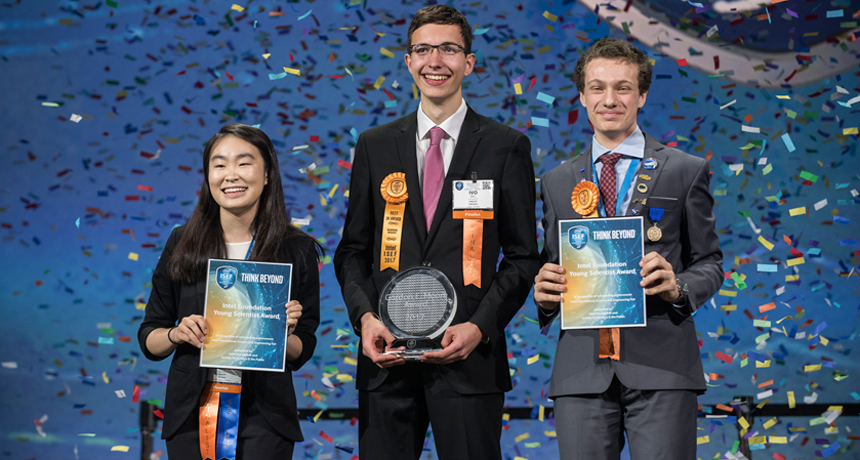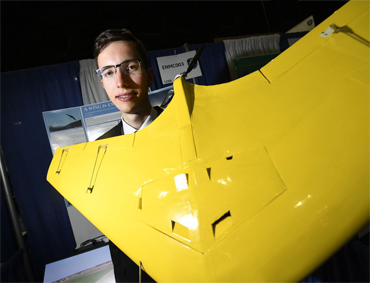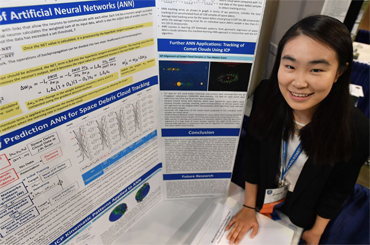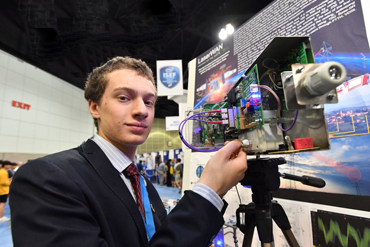Teens garner some $4 million in prizes at 2017 Intel ISEF
Winners built a ‘flying wing,’ tracked space junk and more

These top winners in the 2017 Intel ISEF competition together took home $175,000 in awards. From left: Amber Yang, 18, of the United States; Ivo Zell, 18, from Germany; and Valerio Pagliarino, 17, from Italy.
Chris Ayers/SSP
By Sid Perkins
LOS ANGELES, Calif. — Amidst beautifully clear weather in the City of Angels this week, big awards rained down on teen scientists. Nearly 1,800 were in town to take part in the Intel International Science and Engineering Fair (ISEF). The top winner, 18-year-old Ivo Zell, received $75,000 for his design of a small “flying wing” drone.
The teen attends Schloss Hansenberg International School in Geisenheim-Johannisberg, Germany. The craft he created and flew was inspired by aeronautical research conducted in his home country early in the last century. His project earned him the Gordon E. Moore award. It is named for Intel’s co-founder.
Two other winners each took home huge awards as well. In all, about one-third of all finalists received some sort of award for their research. Together, those awards totaled roughly $4 million.
ISEF has been honoring young researchers since 1950. Created and run by Society for Science & the Public (SSP), it is the world’s largest international pre-college science competition. Now sponsored by Intel, ISEF this year brought together students from 78 countries, regions and territories.
“Congratulations to all our finalists, as well as our top three winners on their extraordinary research projects,” says Maya Ajmera. She’s the president of SSP and publisher of Science News for Students. “As our world grows increasingly complex,” she notes, “we need [their] innovative, transformative ideas to identify new solutions to our world’s most intractable challenges.”
High flying design
On most of today’s aircraft, all parts of the wing — from the body of the aircraft out to the wingtips — generate a relatively smooth distribution of lift. Lift is an upward force that keeps an aircraft aloft. But that lift drops off toward the wingtips, notes Ivo. If you graphed the magnitude of the lift on the wing as seen from the front of the plane, it would look like the top half of an ellipse, he explains.

But early last century, two German brothers thought a different lift pattern might work better. An aircraft that included nothing but a wing would be more stable if the distribution of its lift was bell-shaped, not elliptical. In other words, far more of the lift would be generated nearer the aircraft’s body. But their designs were never tested. So Ivo decided to build his own version of the design to see if it would actually fly. One big benefit of the design: It should be stable enough to fly without needing a sophisticated computer to control it.
Ivo used software to design a small plane with the bell-shaped distribution of lift. Using a 3-D printer, he built the craft’s internal structure from a lightweight plastic. Then, he covered those plastic ribs with thin sheets of balsa, a type of light wood. Finally, he added a plastic coating to help protect the balsa wood from damage. His model had a wingspan of about 1.23 meters (4 feet). And even though the plane’s motor only put out about 400 watts of power, it could fly at speeds up to 160 kilometers (100 miles) per hour.
Ivo has not yet tested his aircraft in a wind tunnel. (That’s a facility where engineers perform all sorts of tests on scale models of vehicles.) But he has flown the model using the same simple radio controls that guide many other types of model aircraft. He confirmed that his design is stable enough to fly without complicated computers. A “flying wing” based on Ivo’s design might experience a bit more drag than one with the normal distribution of lift. But, the teen reports, his design is a lot more stable in flight. “The trade-off of slightly more drag but increased stability would be worth it,” he argues.
Ivo intends to study aeronautical engineering. He also will continue to build and fly small drones. Upon being named the event’s top winner, he modestly expressed his surprise and gratitude: “It feels awesome.”
Tracking orbital threats & getting the internet to remote regions
Amber Yang, 18, came up with a way to predict the orbits of space junk circling Earth. A senior at Trinity Preparatory School in Winter Park, Fla., her research earned a $50,000 Intel Foundation Young Scientist Award.

This teen looked at how clouds of space debris — such as from an exploding satellite — move and rotate. First, she analyzed data about the debris cloud, which had been gathered by radar. She fed those data into a computer that could learn about how clouds of debris move and disperse in space. With data collected during just a 3-hour period (equal to about two orbits of Earth) her technique could estimate where the cloud of junk would be as much as two weeks later.
Amber’s technique could help researchers better schedule rocket launches. After all, no one would want to launch a rocket into a passing cloud of junk traveling at thousands of kilometers per hour. The technique also could help astronauts figure out if the orbit of the International Space Station needed to be shifted to avoid passing junk. (Read more about Amber’s research here.)
Valerio Pagliarino, 17, also won a $50,000 Intel Foundation Young Scientist Award. His research addressed how to get internet service to remote areas. The teen’s proposed solution: transmit data signals via lasers mounted on existing electrical transmission towers.
Valerio attends the I.I.S. Nicola Pellati school in Nizza Monferrato, Italy. What inspired him, he says, was his desire to get online in his small town of some 600 people. “Where I live,” he explains, “I have a terrible internet connection.”
The teen’s design would use lasers to transmit signals between large high-voltage electricity-transmission towers. Those lasers could use either infrared or ultraviolet wavelengths of light.

Transmission towers already exist to carry power to remote areas over high-voltage wires. So these would be a perfect place to attach the laser equipment, Valerio says. The laser-relay systems would need to be sited every kilometer (0.6 mile) or so. The good news, most transmission towers are already closer together than that. When bad weather interfered with the laser signals, the equipment could automatically adjust the width and focus of the beam to keep the connection strong, he says.
Each laser beam could carry up to 100 gigabits of data per second, Valerio suggests. That could easily provide internet service to a town his size, he says.
“Intel congratulates this year’s winners,” says Rosalind Hudnell, president of the Intel Foundation. “Ivo Zell, Amber Yang and Valerio Pagliarino and all of the participants inspire us with their talent and passion for changing the world.”
Other major Intel ISEF 2017 award winners
The following students each won “best of category” awards worth $5,000 in this year’s competition:
Animal Sciences: Jessica Young, 18 of Palm Beach Central High School in Wellington, Fla.
Behavioral and Social Sciences: Erin Smith, 17 of Shawnee Mission West High School in Overland Park, Kansas.
Biochemistry: Karina Movsesian, 18, of První české gymnázium v Karlových Varech in Karlovy Vary, Czech Republic.
Biomedical and Health Sciences: Daniel Zhang, 17, of Westview High School in San Diego, Calif.
Biomedical Engineering: Clara Wagner, 18 of Saginaw Arts and Sciences Academy in Saginaw, Mich.
Cellular and Molecular Biology: Davey Huang, 17 of Iolani School in Honolulu, Hawaii
Chemistry: Kyle Fridberg, 17, of Fairview High School in Boulder, Colo.
Computational Biology and Bioinformatics: Prathik Naidu, 18, of Thomas Jefferson High School for Science and Technology in Alexandria, Va.
Earth and Environmental Sciences: Adam Nayak, 17, of Cleveland High School in Portland, Ore.
Energy: Chemical: Kendra Zhang, 16, of Jericho High School in Jericho, N.Y.
Energy: Physical: Camille Miles, 17, of Niceville High School in Niceville, Fla.
Environmental Engineering: Prashaant Ranganathan, 17, of Carmel Junior College in Jamshedpur, India.
Materials Science: Nicky Wojtania, 17, of Plano West Senior High School in Plano, Texas.
Mathematics: Karthik Yegnesh, 17, of Methacton High School in Eagleville, Pa.
Microbiology: Rahul Subramaniam, 16, of Greenwich High School in Greenwich, Conn.
Plant Sciences: Isabella Bowland, 16, of Fairview High School in Boulder, Colo.
Robotics and Intelligent Machines: Tassilo Schwarz, 18, of Johannes-Heidenhain-Gymnasium Traunreut in Traunreut, Germany
Systems Software: Michael Lee, 18 of Manhasset High School in Manhasset, N.Y.
Translational Medical Science: Jeremiah Pate, 18 of BASIS Oro Valley in Oro Valley, Ariz.
More than a dozen of these “best of category” winners also earned trips overseas. Some will visit research labs in China or India. Others will visit science fairs or attend youth science forums in Europe. Some of the roughly 600 winners at this year’s competition even won college scholarships.
Says Hudnell, “As a diverse and inclusive group developing groundbreaking solutions to global challenges, these young people represent the next generation of innovators.”







